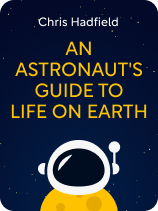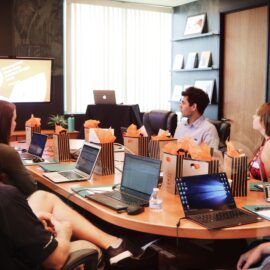

This article is an excerpt from the Shortform book guide to "An Astronaut's Guide to Life on Earth" by Chris Hadfield. Shortform has the world's best summaries and analyses of books you should be reading.
Like this article? Sign up for a free trial here.
What is An Astronaut’s Guide to Life on Earth by Chris Hadfield about? What are the main takeaways of the book?
In An Astronaut’s Guide to Life on Earth, Chris Hadfield traces his journey to becoming an astronaut and the lessons he learned along the way. He further examines several highlights from his 21-year career that will help you find joy in everyday life.
Read below for a brief overview of An Astronaut’s Guide to Life on Earth by Chris Hadfield.
An Astronaut’s Guide to Life on Earth by Chris Hadfield
What can you learn about life on our planet by leaving Earth? Retired astronaut Chris Hadfield explores this question in his memoir, An Astronaut’s Guide to Life on Earth. Chris Hadfield recounts his years as an astronaut and reflects on valuable life lessons he learned while on the job. He says that while he was up in space, he learned how to live a better life on Earth—and by adopting the perspective and behavior of an astronaut, you can also improve your life.
Hadfield served as an astronaut for the Canadian Space Agency for 21 years. During those years, he completed two Space Shuttle missions and spent five months commanding the International Space Station. He may be best known outside the astronaut community for filming and releasing a music video in space—his rendition of David Bowie’s “Space Oddity.” Hadfield published An Astronaut’s Guide to Life on Earth in 2013, the same year he retired. Since retiring, he’s also served as a visiting professor at a Canadian university, co-hosted the BBC show Astronauts: Do You Have What It Takes?, and taught a Masterclass about space exploration.
In Part 1 of this article, we’ll trace Hadfield’s journey to becoming an astronaut, starting with his childhood dream to explore space and ending with the phone call that changed his life. In Part 2, we’ll provide an overview of his career as an astronaut and describe his three space flights. Finally, in Part 3, we’ve organized the insights Hadfield gained as an astronaut into five lessons.
Part 1: Hadfield’s Journey to Becoming an Astronaut
Hadfield can pinpoint the exact moment he decided he wanted to be an astronaut. It was 1969, he was nine years old. He and his family were crowded around the TV, watching Neil Armstrong take his first steps on the Moon. Hadfield wanted a life like Armstrong’s—a life of exploring space and contributing to scientific knowledge.
During his childhood, Hadfield worried that his dream to become an astronaut was unattainable: He lived in Canada, and Canada didn’t have a space agency at the time. The US space agency, NASA, only hired Americans. (Shortform note: Although Canada lagged behind the US in establishing a federal space agency—which they eventually did in 1989—Canadians still contributed to space activities prior to this. For instance, in 1969, the Canadian government joined NASA’s Space Shuttle program. This led to the development of the Canadarm, a robotic arm used in many space missions, including Hadfield’s first space flight.)
Despite the unfortunate reality that his chances of becoming an astronaut were slim, Hadfield decided he’d still take steps that aligned with his goal to become an astronaut. That way, he’d be ready if an opportunity arose. He worked hard in school, studied airplanes in his free time, and eventually earned a pilot’s license.
From Test Pilot to Astronaut
After graduating from high school in 1977, Hadfield enrolled in military college and majored in mechanical engineering, a common major for aspiring astronauts. After marrying his high school sweetheart, he began training to fly fighter jets with the Canadian Forces. He soon realized that he wanted to be a test pilot—at least until he could become an astronaut. He, his wife, and their three children moved to a US Air Force base where he attended and eventually graduated from test pilot school.
(Shortform note: While Hadfield’s plan to become a military test pilot might not seem immediately relevant to his goal of becoming an astronaut, NASA has historically recruited a large number of test pilots as astronauts. For instance, in 1958, NASA hired seven astronauts—all military test pilots—for Project Mercury, their first human spaceflight program. The NASA hiring team reasoned that military test pilots were accustomed to the intensity of high-speed flight and remaining calm in stressful situations—two skills essential for astronauts. In The Right Stuff, journalist Tom Wolfe says that these astronauts also had “the right stuff”—both the courage to put their lives on the line and the skills to stay alive in dangerous situations.)
When Canada finally started its Canadian Space Agency (CSA), Hadfield set his sights on applying to be an astronaut. He continued working as a test pilot, and he spent his evenings and weekends completing a master’s degree in aviation systems so he’d be more qualified to serve as an astronaut.
(Shortform note: A master’s in aviation systems is one of many options for NASA’s requirement that astronaut applicants hold a master’s degree. Other options include a master’s degree in most science, technology, engineering, and mathematics subfields.)Not long after completing his degree, Hadfield applied to the CSA and progressed through countless rounds of intensive interviews and tests. Then, one day in 1992, Hadfield got the call he’d been looking forward to since age nine: He was selected from among over 5,000 applicants to be an astronaut for the CSA.
Part 2: Hadfield’s Career as an Astronaut
Although Hadfield technically became an astronaut the day he received his acceptance call from the CSA, he claims that he actually became an astronaut after years of rigorous, exciting training—training that taught him how astronauts think and behave.
Although most people assume that astronauts spend the majority of their time in space, Hadfield explains that in reality, astronauts spend most of their time on Earth, training to be in space. They study various subjects, run simulations to prepare for space travel, and support the missions of astronauts in space. Hadfield says that he loved this on-Earth training: He enjoyed learning new topics and contributing to every mission, not just his own space flights.
(Shortform note: There’s another reason why astronauts spend most of their job hours on Earth: Time in space takes a negative toll on their bodies. Therefore, they must limit their time in space. Beyond the protection of Earth’s atmosphere, they’re exposed to intense radiation from the sun, increasing their risk of cancer. Furthermore, when they’re in space, astronauts’ bodies grow accustomed to microgravity. They become used to moving around with no little resistance on their bones and muscles, and the fluids in their body (such as their blood and mucus) take time to calibrate. When they return to Earth, their bodies take a while to redistribute fluids and regain bone and muscle strength.)
Hadfield dives into three space missions he took part in. All three flights involved working on space stations that orbit the earth, specifically Mir (The Russian Space Station) and the International Space Station (ISS). For Hadfield’s first two missions, the CSA—which worked with NASA—assigned him to fly on two NASA-operated Space Shuttle flights to Mir and the ISS, respectively. For his last mission, he served as commander of the ISS.
Part 3: Life Lessons Hadfield Learned as an Astronaut
Hadfield claims that the lessons he learned in space improved his life on Earth—and can improve yours as well. These five lessons are:
- When you’re a novice, aim to have a neutral influence
- Plan for the worst possible outcomes
- Proactively show others you care about them
- Find joy in everyday life
- Find fulfillment in supporting others’ success
(Shortform note: Hadfield’s claim that he learned lessons about life on Earth from his vantage point of space may be a result of what psychologists call “the overview effect.” This is the tendency for astronauts to experience awe, feelings of connection to humanity, and a shift in their perspective after viewing Earth from space. Astronauts have described that the “overview effect” is often bittersweet: In viewing the Earth from afar, they’re been overwhelmed by its beauty, its fragility, and the heartbreaking reality that many of its creatures suffer due to environmental degradation and social inequality. Perhaps this bittersweet, powerful feeling contributed to Hadfield’s desire to share the lessons he learned in space.)

———End of Preview———
Like what you just read? Read the rest of the world's best book summary and analysis of Chris Hadfield's "An Astronaut's Guide to Life on Earth" at Shortform.
Here's what you'll find in our full An Astronaut's Guide to Life on Earth summary:
- Chris Hadfield's experience of becoming an astronaut
- The five life lessons Hadfield learned in his role as an astronaut
- Why you should find joy in everyday life rather than looking forward to milestones






